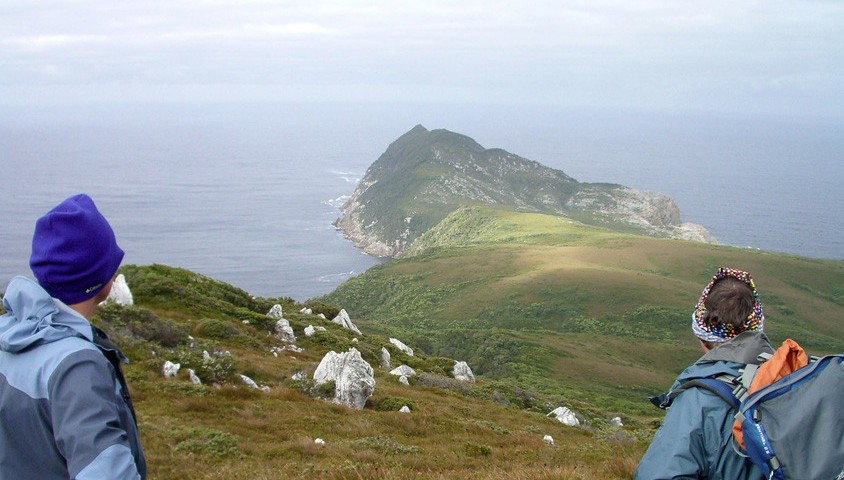This is a tale of an obsession with getting to a lump of rock sticking out into the southern ocean. It is a story of a rather pathetic middle-aged male type of goal that, at first, didn’t seem so hard. As the veils of difficulty of the task were revealed however, the lure became more intense, eating away at the protagonists over many years. Only completion would offer redemption.
The kernels of our obsession started 30 years ago. I was hiking the muddy South Coast Track across the bottom of Tasmania and took a detour to some of the bays west of the standard walk. The area was beautiful, less muddy and less trafficked. A hankering to explore the very southwest corner of the massive Southwest National Park of Tasmania resulted.
It’s not easy to grasp how isolated this area is. There is an abandoned tin mine on Bathurst Harbour called Melaleuca. This lies within a massive national park taking up almost the lower left corner of Tasmania. The park has no roads through it. The old tin mine has a very short dirt airstrip served by a putt-putt local airline intermittently. This airstrip is literally three or more days walk north to the nearest road. There are no huts on the track (none) and sometimes no tracks.
The Focal Point
Three of us (Greg, Rick and myself) hatched a plan to walk the southwest cape circuit in 2009 with a side trip to the last knoll of the southwest cape. It seemed straightforward on paper at the time. John Chapman’s fabled guidebook of hiking southwest Tasmania said the side trip to the actual cape was ‘a long day hike, carry some rope’. Perhaps it should take maybe 10 hours or so as day trip from the last of the southern beaches, Wilsons Bight. We had no idea how difficult this little side jaunt was.
The walk first goes south then west, passing the beautiful and rugged southern beaches to reach Wilsons Bight in two days. Our side trip to the cape seemed in the bag. We started the day trip early with one light pack containing a thin short rope and plenty of bravado. We were greeted by a stiff climb 500-metre climb to the top of Mount Karamu. Finding and keeping the intermittent and overgrown track along the ridge out to the cape was a challenge. We wished a good bushfire would blow through the scrub. It was dawning on us that the cape and its last knoll were very well guarded. In places we crawled through on hands and knees. We regularly bush-bashed our way forward. The scratches incurred on our arms and legs from the scrub were fierce. Each further scratch on top of the others felt like putting salt in a wound. After several hours we got the top of the second last knoll that has a startling view of the last knoll. It didn’t seem far away.
We negotiated several airy descents on the second last knoll towards the last knoll only to be met with the 30-metre cliff. When we saw it up close, we were petrified, almost physically sick. It was all we could do to bring ourselves to look over the edge. The wind had sprung up and it felt like one good gust would send us over the edge. We plastered ourselves against the back wall of a ledge and tried to compose ourselves. We worked up the courage to throw our rope over the edge to see what would happen. Well, the wind whips through the gap between the second and last knolls and the rope went horizontal. We couldn’t even work out if it was long enough to get the bottom.
Our plan to get to the last knoll was rapidly unravelling. There was a colony of seals near the rocks at the base of the cliffs. ‘Go home and show some respect to the last knoll’ they seemed to be barking at us. We turned tail and trudged back through the thick scrub to Mount Karamu and then the long descent to Wilsons Bight, getting in on dusk.
The rest of the southwest cape circuit is an amazing hike. Long days, big climbs, navigational challenges, amazing beaches and campsites, more scrub. Rick and I tried to put the disappointment of the last knoll out of our minds, but Greg felt the failure particularly strongly and it began to eat away at him. Unfinished business – we had been so close. Surely, just a bit of courage and better preparation is all it would take to surmount. The gnawing feeling strengthened over the following three years. Last knoll fever was taking hold…
……The story continues in Wild issue 150. Subscribe today.


